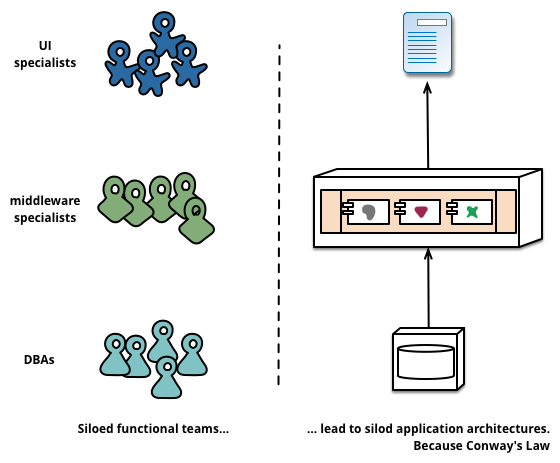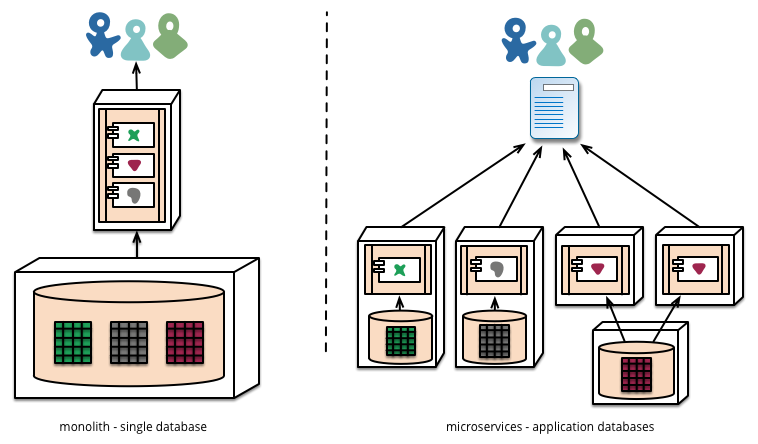Awesome
Spring Boot MicroServices Template
This repository is an example of how to get Microservices going using Spring Boot, Spring Cloud, Spring OAuth 2 and Netflix OSS frameworks.
Table of Content
- Contributors
- Application Architecture
- Using the application
- Microservices Overview
- Netflix OSS
- Spring Boot Overview
- Spring Cloud Overview
- Spring Cloud Config Overview
- Spring Cloud Netflix Overview
- OAuth 2.0 Overview
- Spring OAuth 2.0 Overview
<a name="contributors"></a>Contributors
<a name="application-architecture"></a>Application Architecture
The application consists of 7 different services
- config server - setup external configuration
- webservice-registry - Eureka server
- auth-server - Oauth2 authorization server
- user-webservice - User micro-service
- task-webservice - Task micro-service
- comments-webservice - Comments for task micro-service
- api-gateway - API gateway that proxies all the micro-services
- web-portal - Single Page Application that provides the UI
Target Architecture

Application Components

<a name="using-application"></a>Using the application
<a name="run_local_mc"></a>Running on local m/c
- You can build all the projects by running the
./build-all-projects.shon Mac/Linux systems and then going to each individual folder and running the jars using thejava -jar build/libs/sam<application_name>.jarcommand. - Please refer to the individual readme files on instructions of how to run the services. For demo, you can run the applications in the same order listed above.
<a name="run_docker"></a>Running using docker (NOTE: NOT WORKING with latest docker 1.8x since the gradle docker task is NOT compatible; also bug in Spring Boot 1.2.x)
-
Docker is an open platform for building, shipping and running distributed applications. Follow steps on the site to install docker based on your operating system.
-
Currently there is a bug in Spring Boot 1.2.x that affects the way how JPA starts in an app launched with executable jar. Hence while the docker containers are good to go, we will need to change the application once Spring boot 1.3 is released so that we can run this on docker.
-
Once docker is setup, we would reset the VM so as to start fresh. The examples were developed on Mac so follow these step; they would be fairly similar on Windows.
-
Once you open the docker program through terminal, follow these steps
- Reset the VM =>
boot2docker delete - Start the VM giving it around 8 GB of RAM =>
boot2docker init -m 8192 - Check whether the initialization parameters were successful =>
boot2docker info - Start the VM =>
boot2docker up - To connect the Docker client to the Docker daemon =>
$(boot2docker shellinit)
- Reset the VM =>
-
If you have not added your TLS certs to boot2docker; you would need to change docker to run the API on HTTP; while boot2docker 1.3 comes with TLS enabled. Hence you need to run the following command
$(docker run sequenceiq/socat)at the docker prompt so that this image maps the api to HTTP port. You can check that it is working correctly(returns OK) using the commandcurl http://192.168.59.103:2375/_pingor connect thehttp://192.168.59.103:2375/_pingURL in the browser. -
Run the mysql container using
docker run -d -e MYSQL_ROOT_PASSWORD=password -e MYSQL_DATABASE=auth --name auth-db -p 3306:3306 mysql -
On the mac command prompt, navigate to the root folder of the application (spring-boot-microservices) and run the
./docker-image-all-projects.shcommand. This should build all the images and publish them to docker. -
Run the individual images as below; note that the auth-server and api-gateway images fail because of Spring Boot 1.2.x bug.
- Config Server
- docker run -d --name config-server -p 8888:8888 anilallewar/config-server
- docker logs -f config-server
- Eureka Server
- docker run -d --name registry-server -p 8761:8761 anilallewar/webservice-registry
- docker logs -f registry-server
- OAuth Server
- docker run -d --name auth-server -p 8899:8899 anilallewar/auth-server
- docker logs -f auth-server
- User Webservice
- docker run -d --name user-webservice anilallewar/user-webservice
- docker logs -f user-web service
- Task Webservice
- docker run -d --name task-webservice anilallewar/task-webservice
- docker logs -f task-webservice
- Comments Webservice
- docker run -d --name comments-webservice anilallewar/comments-webservice
- docker logs -f comments-webservice
- Web Portal
- docker run -d --name web-portal anilallewar/web-portal
- docker logs -f web-portal
- Zuul API Gateway
- docker run -d --name api-gateway -p 8080:8080 anilallewar/api-gateway
- docker logs -f api-gateway
- Config Server
-
We also have a docker-compose file that can be used to start all the containers together using
docker-compose up -d. However this doesn't work in our case since our containers need to be started in order e.g. config-server before everything, webservice-registry before rest of Eureka clients. Docker compose starts all containers together and this fails because containers like auth-server, web-portal start before their dependent containers have started. Please see here for more details. -
Note:
- If the gradle wrapper doesn't work, then install gradle and run
gradle wrapperbefore usinggradlew. - If you need to setup the classpath correctly, then run
./gradlew clean build eclipsewhich would setup the.classpathaccordingly.
- If the gradle wrapper doesn't work, then install gradle and run
<a name="microservices-overview"></a>Microservices Overview
There is a growing adoption of Microservices in today's world. Numerous SAAS Companies are moving away from building monolithical products and instead adopting Microservices.
Focus on Component
In microservices world, a web serive or a microservice is the unit of component. This unit of component delivers a complete Business functionality and could rely on other microservices to fullfil that. These microservices are build separately and deployed separately unlike monoliths in which components can be built separately but are deployed together.

Focus on Business Capabilities and Running a Product
Another key aspect of microservices is that the focus of a team building a component now moves away from just delivering that component to running and maintainig that business functionality given by that component.

Focus on Decentralized Control and Decentalized Data Management
Due to the ability to build components separately and running them separately means, the notion of centralized control (goverance) and data management goes away. Traditionally monoliths were built around a set of set architecture, technology and frameworks. The key architects would decide what tech was used and key DBAs would decide which and how many databases are used. With Microservices, since each component caters to a somewhat complete business functionality, that centralized control by Key Architects and DBAs goes away. Some Components are best built using JEE and RDBMS, for some Real time Data Analytics is the key, they could use Apache Storm and Apache Kafka, for some others R is better fit, for IO Intensive systems may Node.js and MongoDB works out. Same way User data could now go in NoSQL databases, Transaction data could go in traditional RDBMS, Recommendation systems could use Hive as their Database and so on.
Decentralized Control 
Decentalized Data Management

Disclaimer - While microservices is much talked about these days, make a note Microservices is not a Free lunch. There is an effort and complexity involved to building and running them, but once you do so, the benefits are plentiful.
You can read more about Microservices here - http://martinfowler.com/articles/microservices.html#CharacteristicsOfAMicroserviceArchitecture
Image References from - http://martinfowler.com/articles/microservices.html
<a name="netflix-oss"></a>Netflix OSS

Netflix is one of the pioneers behind the Microservices Architecture. Not only have they successfully run Microservices in production, but they have outsourced their battle hardened framework under Netflix Open Source Software Center initiative - http://netflix.github.io/#repo
You will find implementation of numerous of Netflix's Microservices platform pieces here. Here are few for your reference
<img src="http://netflix.github.io/assets/repos/eureka.png" width="30px"> Eureka
Microservices is somewhat like SOA platform, that there are numerous services. Each Service when it comes online registers itself with Service Registry. When some other service wants to communicate with a already registered service, they would ask the Eureka Server the base url for that service. Multiple instances of the same service could register with Eureka, in that case Eureka could help in doing Load Balancing.
<img src="http://netflix.github.io/assets/repos/hystrix.png" width="30px"> Hystrix
A Microservices environment is built to sustain failures of its parts, that is few of its microservices. In order to keep the system going, Netflix introduced a concept of circuit breaker. A Circuit Breaker provides alternative behavior in case certain microservice is gone down. This way the system gracefully switches to fallback behavior until the system recovers, rather than entire system suffering the ripple effects of failed service.
<img src="http://netflix.github.io/assets/repos/zuul.png" width="30px"> Zuul
A Microservice environment needs a gateway. A Gateway is the only entity exposed to the outside world, which allows access to Microservices and does more. A Gateway could do
- API Metering
- Centralized Authentication/Authorization
- Load Balancing
- etc
<img src="http://netflix.github.io/assets/repos/ribbon.png" width="30px"> Ribbon
Ribbon is a Load Balancing Client and is meant to work with Eureka Server. Ribbon talks to Eureka server and relies on it to get base url to one of the instances of microservice in question.
<a name="spring-boot-overview"></a>Spring Boot Overview
Folks who are familiar with Spring frameworks like Spring MVC, know spring is all about Dependency Injection and Configuration Management. While Spring is an excellent framework, it still takes quite some effort to make a Spring MVC project ready for production.
Spring Boot is Spring's approach towards Convention over Configuration. Spring Boot comes with numerous Start Projects, each starter projects provides a set of conventions which ensures you have a opinionated production ready app.
To begin with Spring Boot allows you to write web services with just One or two classes. See the example below
build.gradle
gradle dependency --> compile("org.springframework.boot:spring-boot-starter-web")
Application.java
@SpringBootApplication
public class Application{
public static void main(String[] args){
SpringApplication.run(Application.class, args);
}
}
UserController.java
@RestController
public class UserController{
@RequestMapping("/")
public User getUser(String id) {
return new User(id,"firstName","lastName");
}
}
Build
$>./gradlew clean build
say this Generates app.jar
Running Application
$>java -jar builds/lib/app.jar
The idea is to have multiple projects like above, one for each microservice. Look at the following directories in this repo
- https://github.com/rohitghatol/spring-boot-microservices/tree/master/user-webservice
- https://github.com/rohitghatol/spring-boot-microservices/tree/master/task-webservice
You can read in detail about Spring Boot here - https://spring.io/guides/gs/spring-boot/
<a name="spring-cloud-overview"></a>Spring Cloud Overview
Spring Cloud provides tools for developers to quickly build some of the common patterns in distributed systems (e.g. configuration management, service discovery, circuit breakers, intelligent routing, micro-proxy, control bus, one-time tokens, global locks, leadership election, distributed sessions, cluster state)
You can read in detail about Spring Cloud here - http://projects.spring.io/spring-cloud/
<a name="spring-cloud-config-overview"></a>Spring Cloud Config Overview
Spring Cloud config provides support for externalizing configuration in distributed systems. With the Config Server you have a central place to manage external properties for applications across all environments.
You can read in detail about Spring Cloud config here - http://cloud.spring.io/spring-cloud-config/
<a name="spring-cloud-netflix-overview"></a>Spring Cloud Netflix Overview
Spring Cloud Netflix provides Netflix OSS integrations for Spring Boot apps through autoconfiguration and binding to the Spring Environment and other Spring programming model idioms.
You can read in detail about Spring Cloud Netflix here - http://cloud.spring.io/spring-cloud-netflix/
<a name="oauth-2.0-overview"></a>OAuth 2.0 Overview
OAuth2 is an authorization framework that specifies different ways a third-party application can obtain limited access to determined set of resources.

OAuth defines four roles:
resource owner: An entity capable of granting access to a protected resource. When the resource owner is a person, it is referred to as an end-user.
resource server: The server hosting the protected resources, capable of accepting and responding to protected resource requests using access tokens.
client: An application making protected resource requests on behalf of the resource owner and with its authorization. The term "client" does not imply any particular implementation characteristics (e.g., whether the application executes on a server, a desktop, or other devices).
authorizationserver: The server issuing access tokens to the client after successfully authenticating the resource owner and obtaining authorization.
To get more details of how differnt authorizations work in OAuth2, please refer to the readme at auth-server
<a name="spring-oauth-2.0-overview"></a>Spring OAuth2 Overview
Spring provides nice integration between Spring security and OAuth2 providers including the ability to setup your own authorization server. Please see Spring security with OAuth2 for more details.